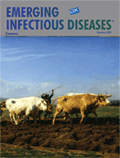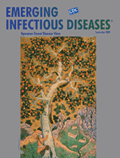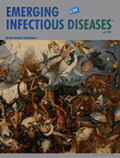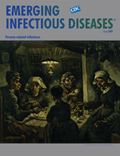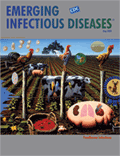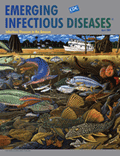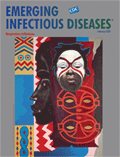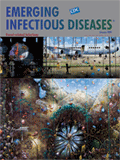Podcasts
New Podcasts
National Surveillance of Human Ehrlichiosis Caused by Ehrlichia ewingii, United States, 2013-2021
Homelessness and Bartonella quintana Infections
Thelazia callipaeda Eyeworms in American Black Bear, Pennsylvania, USA, 2023
Infectious Diseases and Clinical Xenotransplantation
Past Podcasts
Volume 7-2001 and Volume 5-1999 are links to podcasts recorded in 2015 about articles that appeared in EID during those years. Volume 12-2006 is a link to a podcast recorded in 2018.
Volume 15—2009
Underreporting of 2009 H1N1 Influenza Cases
Influenza cases are difficult to track because many people don't go to the doctor or get tested for flu when they're sick. The first months of the 2009 H1N1 influenza pandemic were no different. In this podcast, CDC's Dr. Carrie Reed discusses a study in the December issue of Emerging Infectious Diseases that looked at the actual number of cases reported and estimated the true number of cases when correcting for underreporting.
Download Transcript
View full-text article: Estimates of the Prevalence of Pandemic (H1N1) 2009, United States, April–July 2009
Identification of the First Chinese Cases of H1N1 Flu
In this podcast, Dr. Scott Dowell discusses the first cases of the new H1N1 influenza virus in China in May 2009, which occurred in three students who had been studying in North America during the early days of the pandemic and returned home to visit their friends and family. Chinese health officials acted swiftly to investigate and determine whether the students had spread their illness to others. The article, which appears in the September 2009 issue of Emerging Infectious Diseases, details what they found.
Download Transcript
View full-text article: Clinical and Epidemiologic Characteristics of 3 Early Cases of Influenza A Pandemic (H1N1) 2009 Virus Infection, People’s Republic of China, 2009
Investigation of Sylvatic Typhus at a Wilderness Camp
In this podcast, Dr. Greg Dasch discusses an outbreak of four cases of sylvatic typhus that occurred at a wilderness camp in Pennsylvania. Sylvatic typhus is very rare in the United States, with only 41 cases since it was discovered in the United States in 1975. Lab work at CDC and the discovery that all four camp counselors who became ill had slept in the same bunk at the camp between 2004 and 2006 ultimately led to confirmation that flying squirrels living in the wall of the cabin were to blame for the illnesses.
Download Transcript
View full-text article: Cluster of Sylvatic Epidemic Typhus Cases Associated with Flying Squirrels, 2004–2006
Bartonella quintana in Homeless Persons
In this podcast, Dr. Marina Eremeeva discusses an article about Bartonella quintana in homeless populations in San Francisco. Bartonella quintana is a bacterium that is transmitted by human body lice. Findings by the article’s authors suggest that Bartonella quintana may be transmitted by head lice. This could mean that populations other than homeless populations, such as school children, might be at increased risk for Bartonella quintana.
Download Transcript
View full-text article: Bartonella quintana in Body Lice and Head Lice from Homeless Persons, San Francisco, California, USA
Avian Influenza A (H5N1)
In this podcast, CDC's Dr. Tim Uyeki discusses H5N1, a subtype of influenza A virus. This highly pathogenic H5N1 virus doesn't usually infect people, although some rare infections with H5N1 viruses have occurred in humans. We need to use a comprehensive strategy to prevent the spread of H5N1 virus among birds, including having human health and animal health work closely together.
Download Transcript
View full-text article: Seroprevalence of Antibodies to Avian Influenza Virus A (H5N1) among Residents of Villages with Human Cases, Thailand, 2005
Clostridium difficile in Retail Meats
Clostridium difficile is a common cause of diarrhea in healthcare settings but little is known about what causes cases in the community. In this podcast, CDC's Dr. L. Clifford McDonald discusses two papers in the May 2009 edition of Emerging Infectious Diseases that explore whether the organism could be found in meat samples purchased in grocery stores in Arizona and Canada.
Download Transcript
View full-text article: Clostridium difficile in Retail Meat Products, USA, 2007
Clostridium difficile in Retail Meats
Clostridium difficile is a common cause of diarrhea in healthcare settings but little is known about what causes cases in the community. In this podcast, CDC's Dr. L. Clifford McDonald discusses two papers in the May 2009 edition of Emerging Infectious Diseases that explore whether the organism could be found in meat samples purchased in grocery stores in Arizona and Canada.
Download Transcript
View full-text article: Possible Seasonality of Clostridium difficile in Retail Meat, Canada
Health Concerns in the Amazon Region
Residents of the Amazon region of South America contend with a number of health threats - from mosquito-borne diseases to difficulty accessing doctors and healthcare facilities in such a vast area. This podcast helps explore some of the health issues in the region and what's being done to address them.
Download Transcript
View full-text article: The Status of Infectious Disease in the Amazon Region
Exotic Small Mammals and Bartonella
In this podcast, Dr. Nina Marano discusses Bartonella, a bacterial agent that's prevalent in many species, including cats, dogs, and cattle. Wild animals are normally thought to carry Bartonella, so when animals are caught in the wild for pet trade, the risk that humans can become infected with Bartonella increases. Bartonella is an identified risk associated with ownership of exotic animals and has serious health consequences.
Download Transcript
View full-text article: Exotic Small Mammals as Potential Reservoirs of Zoonotic Bartonella spp.
Strategies for Fighting Pandemic Flu in Developing Countries
Countries throughout the world are preparing for the next influenza pandemic. Developing countries face special challenges because they don't have antiviral drugs or vaccines that more developed countries have. In this podcast, CDC's Dr. Dan Jernigan discusses new and innovative approaches that may help developing countries fight pandemic flu when it emerges.
Download Transcript
View full-text article: Meeting the Challenge of Influenza Pandemic Preparedness in Developing Countries
Influenza Pandemic Infrastructure Response in Thailand
Influenza viruses change antigenic properties, or drift, every year and they create seasonal outbreaks. Occasionally, influenza viruses change in a major way, called a 'shift.' If an influenza virus shifts, the entire human population is susceptible to the new influenza virus, creating the potential for a pandemic. On this podcast, CDC's Dr. Scott Dowell discusses responding to an influenza pandemic.
Download Transcript
View full-text article: Capacity of Thailand to Contain an Emerging Influenza Pandemic
Sporadic Creutzfeldt-Jakob Disease (sCJD)
In this podcast, Dr. Lynne Sehulster discusses Creutzfeldt-Jakob disease, a rare neurodegenerative disease. This disease is caused by a pathological accumulation in the brain of an abnormal protein known as prions.
Download Transcript
View full-text article: Medical Procedures and Risk for Sporadic Creutzfeldt-Jakob Disease, Japan, 1999–2008
Use of Protective Gear in Bird Flu Outbreak Response
CDC's Dr. Oliver Morgan discusses how the use of masks and other protective gear impacted whether workers dealing with an outbreak of bird flu in England became sick. The paper is published in the January 2009 issue of CDC's journal, Emerging Infectious Diseases.
Download Transcript
View full-text article: Personal Protective Equipment and Risk for Avian Influenza (H7N3)
Rotaviruses
CDC's Dr. Jon Gentsch discusses rotaviruses, the most important cause of severe gastroenteritis in children less than five years of age. Essentially, all children around the world get the disease during the first few years of life.
Download Transcript
View full-text article: Novel Human Rotavirus Genotype G5P[7] from Child with Diarrhea, Cameroon
The conclusions, findings, and opinions expressed by authors contributing to this journal do not necessarily reflect the official position of the U.S. Department of Health and Human Services, the Public Health Service, the Centers for Disease Control and Prevention, or the authors' affiliated institutions. Use of trade names is for identification only and does not imply endorsement by any of the groups named above.
